Lead Pricing
| Interior | Outside | Balcony | Suite |
|---|---|---|---|
| Request Price | Request Price | Request Price | Request Price |

At Aurora Expeditions wilderness is a passion they share with others by taking small groups of like-minded people to some of the most isolated places on our planet. From the polar regions of Antarctica and High Arctic to the wilds of Costa Rica, Scotland, Patagonia and more, Aurora Expeditions aims to create special expedition-style cruises that foster an understanding and appreciation of our natural world.
The Australian-owned adventure company was initially established in the early 1990¹s by adventures Greg Mortimer and Margaret Werner when they began sharing their love of remote places by organising ship-based trips for keen friends and fellow travellers. Their style to push the boundaries¹ has remained unchanged and they are proud of the fact that their spirit of adventure and exploration is as strong as ever. Their adventure activities are proof of this; with many of their voyages offering polar scuba diving, sea kayaking, camping and mountain climbing.
Deeply committed to education and preservation of the environment, Aurora Expeditions were the founding member of both the International Association of Antarctic Tour Operators (IAATO) and the Association of Arctic Expedition Cruise Operators (AECO). All their voyages have expert expedition staff who will help to unlock the wonders of these special places.
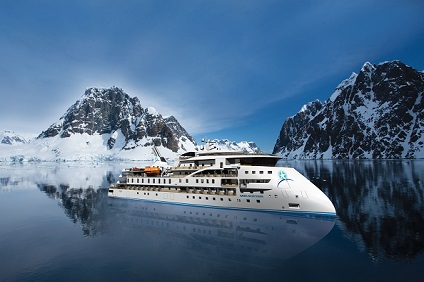
Deck: 3 | Quantity: 15 | Size: 23.2 m2
Cabin Features
Twin or double bed
Private En-suite
Porthole window
Desk area
Closet space
Sofa bed (can sleep 3rd passenger in select cabins)
Room-controlled thermostat
Safe for storing valuables
42″ flat-screen TV
Deck: 3 | Quantity: 15 | Size: 23.2 m2
Cabin Features
Twin or double bed
Private En-suite
Porthole window
Desk area
Closet space
Sofa bed (can sleep 3rd passenger in select cabins)
Room-controlled thermostat
Safe for storing valuables
42″ flat-screen TV
Decks: 4 & 6 | Quantity: 58 | Cabin and balcony combined size: 16.1m2 – 21m2. Cabin Features Twin or double bed Private En-suite Floor to ceiling window Desk area Closet space Private balcony Room-controlled thermostat Safe for storing valuables 42″ flat-screen TV
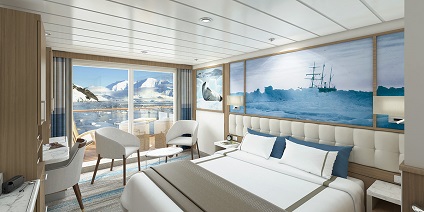
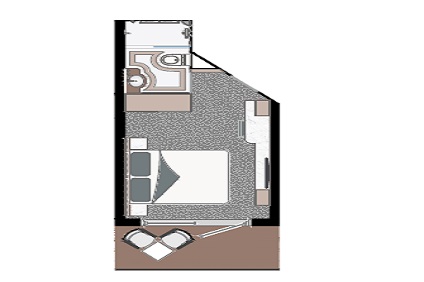
Decks: 4 & 6 | Quantity: 58 | Cabin and balcony combined size: 16.1m2 – 21m2. Cabin Features Twin or double bed Private En-suite Floor to ceiling window Desk area Closet space Private balcony Room-controlled thermostat Safe for storing valuables 42″ flat-screen TV
Decks: 4 & 6 | Quantity: 58 | Cabin and balcony combined size: 16.1m2 – 21m2. Cabin Features
Twin or double bed
Private En-suite
Floor to ceiling window
Desk area
Closet space
Private balcony
Room-controlled thermostat
Safe for storing valuables
42″ flat-screen TV
Deck: 4 | Quantity: 2 | Cabin and balcony combined size: 30.5m2 – 40.2 m2.
Cabin Features
Twin or double bed
Private en-suite
Full size window
Desk area
Closet space
Private balcony
Room-controlled thermostat
Safe for storing valuables
42″ flat-screen TV
Deck: 7 | Quantity: 4 | Cabin and balcony combined size: 38.9 m2. Cabin Features
Twin or double bed
Private en-suite
Full size window
Desk area
Closet space
Private balcony
Room-controlled thermostat
Safe for storing valuables
42″ flat-screen TV
Seperate lounge area
Deck: 4 | Quantity: 1 | Cabin and balcony combined size: 44.5 m2. Cabin Features
Twin or double bed
Private en-suite
Full size window
Desk area
Closet space
Private balcony
Room-controlled thermostat
Safe for storing valuables
Seperate lounge area
42″ flat-screen TV


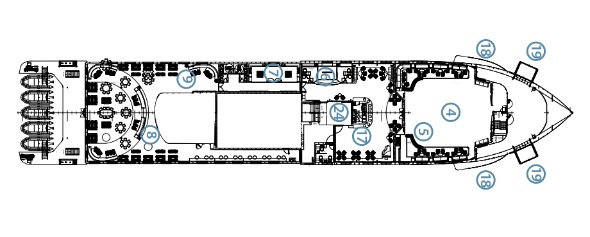

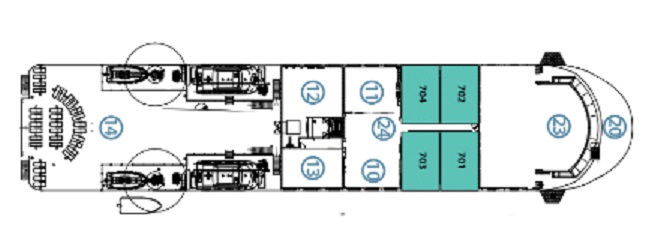
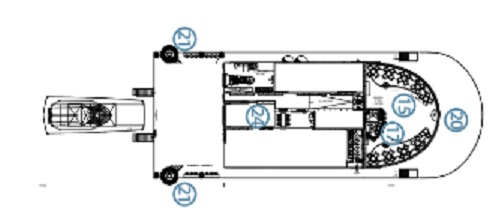
Aurora Expeditions is excited to be launching their new ship, the Greg Mortimer, ready for the Antarctic season in, 2019.
Proudly named after Aurora’s adventurous co-founder, this 104-metre ship is Aurora’s very first, purpose-built expedition vessel. Capable of negotiating the strongest winds and waves, the Greg Mortimer is built to world-class polar standards – designed in close consultation with their expedition specialists, taking advantage of more than 27 years of experience.
Whether it’s adventure, wildlife or simply relaxing that draws you to the planet’s wildest places, the Greg Mortimer will deliver the best expedition cruising experience. The Greg Mortimer will continue to retain Aurora’s ethos and focus on multiple landings, flexible itineraries, environmental sensitivity and family-built atmosphere.
Ship Profile & Stats
- Length: 104 metres
- Tonnage: 7,400
- Maiden Voyage: 2019
- Passenger Capacity (dbl): 160
- Ship Registration: Bahamas
Ship Facilities
- Ship Shop
- Lounge / Lecture Theatre
- Reception
- Change Room / Mudroom
- Zodiac Landing Platforms
- Activity Launching Platform
- Dining Room
- Photography & Art Room
- Library
- Gym
- Sauna / Wellness Centre
- Sun Deck
- Observation Lounge
- Top Deck
- Bars
- Viewing Platforms
- Hydraulic Platforms
- Observation Deck
- Jacuzzis / Plunge Pools
- Medical Centre

Cruise Itinerary
| Date | Activity | Arrive | Depart |
|---|---|---|---|
| 16 Apr '22 | San Jose, Costa Rica |
Hotel | |
| 17 Apr '22 | San Jose, Costa Rica |
Transfer to Puerto Caldera | |
| 17 Apr '22 | Puerto Caldera, Costa Rica |
Embark | |
| 18 Apr '22 | Curu Wildlife Refuge, Costa Rica |
||
| 19 Apr '22 | Manuel Antonio Park, Costa Rica |
||
| 20 Apr '22 | Osa Peninsula, Costa Rica |
||
| 21 Apr '22 | Golfo Dulce, Costa Rica |
||
| 22 Apr '22 | Coiba Island, Panama |
||
| 23 Apr '22 | Coiba Island, Panama |
||
| 24 Apr '22 | Pearl Islands, Panama |
||
| 25 Apr '22 | Darien Jungle,Panama |
||
| 26 Apr '22 | Panama City, Panama |
||
| 27 Apr '22 | Panama Canal |
||
| 28 Apr '22 | At sea | ||
| 29 Apr '22 | Cartagena, Colombia |
Disembark | Hotel |
| 30 Apr '22 | Cartagena, Colombia |
All itineraries and ports of call at the discretion of the cruise line subject to local weather conditions and may change without notice.
12 Night Cruise sailing from Puerto Caldera to Cartagena aboard Greg Mortimer. Hotel stay pre-cruise in San Jose and post-cruise in Cartagena.
Day 1 San José
Upon your arrival at San José make your way to the hotel. Upon check-in, please remind reception staff to provide you with your Aurora Expeditions cabin tags. Please fill out the luggage tags clearly, showing your name and cabin number so that we can deliver your luggage to your cabin ahead of your arrival. Enjoy the remainder of the day at leisure.
Day 2 Puerto Caldera, embark Greg Mortimer
After a leisurely buffet breakfast, transfer to Puerto Caldera (2-hours) where your vessel awaits. After boarding, you’ll have time to settle into your cabin before participating in important safety briefings. Afterwards, enjoy lunch on board as you sail to nearby Isla Tortuga (Turtle Island), where can snorkel, swim, paddle or relax. The water is teeming with a dizzying array of tropical fish, big pufferfish, turtles, sting rays, white tip reef sharks, and occasionally dolphins. Isla Tortuga we will do our kayak orientation and have our first introductory paddle.
This evening, get to know your fellow expeditioners, expedition team and crew at a welcome dinner to celebrate the start of a thrilling adventure.
Day 3 Curú National Wildlife Refuge
Curú National Wildlife Refuge is a privately owned and managed nature preserve offering visitors some of the best eco-tourism experiences in Costa Rica. The refuge is the first privately owned refuge in Costa Rica and is an example of a successful sustainable development program, offering over 3700 acres of tropical forests, mangrove swamps, and grassy fields sitting right along the coastline. 17 hiking trails wind through the varied terrain and you may see white-tail deer or catch a glimpse of armadillos or iguanas. Monkeys are prolific including the native capuchin, spider, and howler monkeys. Located on the southern Nicoya Peninsula of northwestern Costa Rica, the area is teeming with abundant wildlife and hosts one of the most beautiful beaches and protected bays on the Nicoya Peninsula, where we hope to go for a paddle and swim.
Day 4 Manuel Antonio National Park
Boasting over 100 species of mammals, 184 species of birds and a plethora of diverse flora, Manuel Antonio National Park is a paradise for wildlife lovers. Costa Rica’s star attractions – two and three toed sloths, white-faced monkeys and toucans can all be found on hikes that weave through the park. Hiking trails snake their way through the parkland offering access to its rainforest, waterfalls and remote white sand beaches whilst from the water we can snorkel, kayak and paddleboard to view the exquisite coral.
We anchor off the shores of Espadilla Beach and Zodiac to shore for a wet landing. Walk along this soft-sand beach or follow a trail through the rainforest parallel to the beach to get to Playa Manuel Antonio, which is the most popular beach inside the park. It’s a short, deep crescent of white sand backed by lush rainforest. There are numerous clearly-marked hiking trails to choose from – a circular loop trail (1.4 km/0.9 mi) around a high promontory bluff, which includes a visit to the highest point on this hike – Punta Catedral, which offers spectacular views, takes approximately 25 to 30 minutes return. The hiking trails in Manuel Antonio National Park offer excellent opportunities to spot monkeys, sometimes sloths, agoutis, armadillos and coatis.
Day 5&6 Osa Peninsula and Gulfo Dulce
Over the next two days, we explore the untamed Osa Peninsula, considered by National Geographic to be ‘one of the most biologically intense places on earth’. Considered to be the crown jewel of Costa Rica’s park system, Corcovado National park is the country’s largest and one of the most remote parks in Costa Rica. It is home to the largest and only tropical primary lowland rainforest in the world, provides habitat for a plethora of endangered plant and animal species including the scarlet macaw, various frogs, and the tapir – the largest terrestrial mammal in Central and South America. In order to conserve the integrity of the national park, restrictions are placed on the capacity of daily visitors permitted in the park. We therefore hike through a private conservation reserve adjoining the national park looking not only for wildlife, but also to experience the incredible wet tropical rainforest filled with tall trees measuring over 60 m /197 ft, lianas, epiphytes, palms, gingers and orchids.
The following day, we will round the peninsula’ most southern point to enter Gulfo Dulce, or Sweet Gulf. The large bay hugs pristine beaches, rivers and tall evergreen forest, a protected area known as the Golfo Dulce Forest Reserve. As one of the wettest places on Earth with over 200 inches/5000 mm of rainfall a year, the Golfo Dulce Forest Reserve boasts some of the tallest ancient trees. Established in 1979, the Golfo Dulce Forest Reserve was created to protect the lowland forested areas that surround the gulf – the reserve also connecting other national parks in the area. We visit a private reserve called Casa Orquideas (Orchid House), akin to a botanical garden adjoining Piedras Blancas National Park. A hike in Casa Orquideas allows you to appreciate colourful orchids, heliconias, palms, and all the tropical wildlife such as toucans, macaws, tanagers, and honey creepers that feed from the flowers. The warm tropical waters in the gulf are a popular playground for dolphins – perfect for snorkelling, paddle-boarding, kayaking, and Zodiac cruising.
Day 7 Coiba National Park, Panama
Leaving Costa Rica behind, we sail through the Panamanian islands of Coiba National Park, located off the southwest coast of Panama and inscribed as by UNESCO as a place of outstanding universal value. The national park protects Coiba Island, 38 smaller islands and the surrounding marine areas within the Gulf of Chiriqui. Protected from the cold winds and effects of El Niño, Coiba’s Pacific tropical moist forest maintains exceptionally high levels of endemism of mammals, birds and plants due to the ongoing evolution of new species. It is also the last refuge for a number of threatened animals such as the crested eagle. The property is an outstanding natural laboratory for scientific research and provides a key ecological link to the Tropical Eastern Pacific for the transit and survival of pelagic fish and marine mammals.
Due to Coiba Island (the main island in the archipelago) previously serving as a penal colony, access to the island was heavily restricted. As a result, nearly 80 percent of the islands’ natural resources have remained untouched and flourished because of limited human contact. Coiba National Park is managed by the National Authority for the Environment (ANAM) and is accessible only by permit from ANAM. With its designations as a National Park and UNESCO protection, Isla Coiba, its surrounding waters and island neighbours have been given a greater degree of protection. Despite being subject to poaching, illegal logging and other trespasses, the Panamanian government has taken a large step in their preservation.
On Coiba Island, we plan to spend the morning at Granito de Oro islet, a unique place which offers the casual snorkeller a diversity and volume of marine life that many avid scuba divers spend their lives trying to see. The waters surrounding are considered one of the best diving destinations in the world. Enjoy the morning snorkelling among abundant marine life, kayaking around rocky outcroppings, and basking on the warm sand. At Granito de Oro you can also enjoy hiking the “Monkey Trailâ€. The forest here is home to rare indigenous flora, and provides sanctuary for wildlife such as mantled howler monkeys and crested eagles, as well as threatened bird species such as the crested eagle.
Day 8 Coiba National Park, Panama
From 1919 to 2004, the penal colony on Coiba Islands was home to Panama’s most dangerous criminals and political prisoners. At the peak of its operations, the prison housed up to approximately 3,000 inmates in about 30 camps spread around the islands. We spend the morning on the hiking trails that lead to a number of waterfalls, hot springs. Remains of the prison, now roofless and rusted, can still be found at Damas Bay on the eastern side of the island. Back on board, enjoy lunch as we set towards the Pearl Islands.
Day 9 Pearl Islands
The Pearl Islands of Panama is an archipelago located in the North Pacific Ocean in the Gulf of Panama, covering around 250 small islands. The Spanish Conquistadors discovered the islands in 1503 and gave the Islands its name due to the great amounts of pearls found on them. The Pearl Islands were originally named by the Spanish explorer Vasco Nuñez de Balboa due to the bountiful pearls that were harvested off the islands’ shores. The Pearl Islands are most famous for their spectacular and tranquil white sand beaches, untouched forests, and colourful coral reefs offshore – ideal for diving, snorkelling and kayaking.
The largest of the islands is Isla Del Rey but Isla Contadora is the only destination in the archipelago that is equipped with enough infrastructure to attract a large number of visitors. In addition to Isla Contadora, we plan to visit a few nearby islands including Bartolome to enjoy some aquatic activities before exploring Pachequilla, and Pacheca island, also known as Isla de Los Párajos (Bird Island) because it hosts several colonies of seabirds.
Day 10 Emberá Mogue Village, Darién, Panama
There are few places on Earth like the Darién – a region of great interest to biologists, anthropologists, and a notorious route for smuggling narcotics. It is a place of immense natural beauty, where life in the rainforest has remained relatively unchanged for the indigenous communities that live there. It is Panama’s last frontier. The Darién is enormous. The province itself spans some 16,671 square kilometres (6,437 square miles) and contains Panama’s largest national park and most the country’s most extensive lowland tropical forest. However, with only 40,000 inhabitants, the Darién is also the most sparsely populated part of Panama. Its residents live in small, impoverished towns, and include members of the Guna and Emberà -Wounaan indigenous groups.
For many, the Darién is little more than the place where the Pan-American Highway ends and the Darién Gap begins. The gap is the only missing link in a system of roads that connects North and South America, all the way from Alaska to Patagonia. Darién National Park, which spans a total of 579,000 hectares (1,430,740 acres), is the largest national park in Central America. Rarely visited, the region is characterized by unspoiled sandy beaches, jagged rocky coasts, mangrove swamps, and tropical forests bursting with endemic and rare species of plants and birds such as the scarlet macaw, toucan and harpy eagle. Mammals include ocelot, jaguar, Baird’s tapir, anteater, sloth, coatis and kinkajou, In an effort to save the Darién from being poached by loggers and developers, UNESCO inscribed the Darien National Park into its list of World Heritage Sites in 1983.
You will visit Mogue, an Emberá community in the Darién, a remote destination where you will be rewarded with a unique look at a traditional Emberá village. The village is accessible after a 30-minute Zodiac ride (during high tide) up the scenic and swampy Mogue River surrounded by rainforest. You may see birds such as willets, whimbrels, and laughing falcons. Nearing the village, we will be warmly welcomed by the community leaders who will meet our Zodiacs and personally transfer us to their village using their traditional boats. On arrival, the village is a 15-minute walk from the shore of the river. Mogue was established by the indigenous Emberá in the 1960s and tourism plays a substantial role in sustaining its existence.
Upon arriving at the village, the Emberá women will perform a traditional blessing dances to welcome us followed by a more formal welcome by the main ‘Nocoe’ (chief). It is customary for the Emberá to share food and fruits of the season with visitors. Local artisans are proud to show you their handicraft skills such as woodcarving, mask-making, weaving and jewelry-making – all available for purchase, and a wonderful way to directly support the community. On guided hikes, you might be able to spot a harpy eagle or crested eagle—the nests of both birds have been spotted here in the past.
Day 11 Panama City
Three million years ago, the Isthmus of Panama emerged from the sea and changed the world forever. It divided an ocean and joined two continents together, triggering one of the most important natural evolution events in the history of the world. Today, this narrow land bridge in Central America is home to more species of birds and trees than the whole of North America. Panama is of course world-famous for its 77 km / 48 mi canal that connects the Pacific Ocean with the Atlantic Ocean.
Panama’s history has been formed by a rich pre-Columbian era for more than 12,000 years. Early cultures in Panama were the Monagrillo, the Cueva and the Conte, particularly famous for their pottery, which was the first in the Americas. The first European claiming the territory of today’s Panama was Rodrigo de Bastidas, coming from Colombia’s Atlantic coast in 1501. In 1513 Vasco Nuñez de Balboa became the first Spaniard to see the Pacific Ocean from the top of a hill. Four days later he and his men stood at the shores of the Pacific Ocean. In 1519 Panama City was founded, and became an important hub for seized goods making its way from Peru to Spain.
In 1671, English buccaneer Henry Morgan looted and completely destroyed Panama City. These ruins of Old Panama (Panama la Vieja) are open to visitors. In the same decade, a new city and what’s today known as Casco Viejo was constructed 10 km / 6.2 mi away from Panama la Vieja.
Day 12 Panama Canal Crossing
Crossing the Panama Canal will surely be a highlight for many travellers. Each year, over a million people visit the canal to witness this engineering marvel at work. Starting in the Pacific Ocean, you will be able to admire the Bay of Panama and Panama City’s splendorous skyline before passing under the ‘Bridge of the Americas’. The vessel will then transit through the first set of locks, the Miraflores Locks, where it will be lifted 16 metres in two distinct steps. Next, your ship will enter Miraflores Lake, which is a small artificial body of fresh water that separates Pedro Miguel Locks from Miraflores Locks. The vessel will transit through Pedro Miguel Locks, which is one of the two sets of locks on the Pacific side, and here the vessel is lifted 9 metres in one step. After exiting Pedro Miguel locks, your boat will travel through the Gaillard Cut, where the Chagres River flows into the canal. The Gaillard Cut (also known as Culebra Cut because its curves resemble a snake) is one of the main points of interest for visitors because it was carved through the Continental Divide and this section of the canal is full of history and geological value.
As you transit the cut you will see dredging occurring to control the sediments entering the canal because of the terrain’s susceptibility to landslides. Sail through Gatun Lake, which was formed by erecting the Gatun Dam across the Chagres River, and during your transit through the lake, you will pass the Smithsonian Research Station at Barro Colorado. The last of the three locks in the Gatun Locks, the only set of locks in the Atlantic sector. At Gatun Locks, the vessel will be lowered a total of 26 metres in three distinct chambers.
The complete crossing from the Pacific to the Atlantic Ocean takes approximately 10 hours, a journey that once took almost two weeks to complete, where vessels were forced to sail around the notoriously rough seas around Cape Horn at the bottom of South America to reach the Pacific coast.
Day 13 At Sea
Sail to Cartagena de Indias, Colombia. While at sea, enjoy a few final presentations from our team of experts. Edit photos, finish the book you’ve been enjoying, or simply relax on your private balcony or in one of the many public spaces on board the ship.
Day 14 Cartagena de Indias
Disembark in Cartagena de Indias, Colombia, inscribed by UNESCO as a site of Outstanding Universal Heritage. The city’s rich history, diverse culture and energy captivates visitors with its vibrancy, Afro-Caribbean character, indigenous influences and some of the best-preserved colonial architecture in all of South America.
Founded in 1533 by Pedro de Heredia, Cartagena was formerly one of the gateways to the Caribbean for the Spanish. It was here they would store the riches plundered from South America before they were transported back to the old world. It is not surprising therefore that the city drew the attention of buccaneers and pirates who attempted, on many occasions, to seize the city, most notably by Sir Francis Drake who in 1586, “mercifully” agreed not to destroy the city in return for 10 million pesos. It was after the attack by Drake that plans were made to fortify the city and work on the defensive fort walls began. These walls, still stand today, and mark the boundary between the old and new parts of the city. The walls and fort, now a UNESCO World Heritage Site, took a total of 200 years to build and complete, and the Spanish finished them just 25 years before Colombia gained Independence.
Today’s introductory tour will take you through Cartagena’s old town under the Puerta Del Reloj (Clock tower entrance) into the Plaza de los Coches. Your expert local guide will tell stories of the myths and legends, histories and stories of Cartagena from ancient times right up to the present. From the Plaza San Pedro Claver with its stunning Church, to the Plaza Bolivar with its shady areas, where you can watch the world go by. During the walk you will visit the Inquisition Palace, built in the 17th century, and considered one of the most elegant and characteristic colonial constructions in its time.
A short walk away and your final stop is a visit to San Pedro Claver Cloister, monastery and museum built in homage to San Pedro – the protector of slaves. The cloister where Pedro Claver lived and died has become a special place of silence, and reflection – a shrine to his life’s work. Here, visitors will find examples of pre-Colombian ceramics and a museum filled with religious art. Adjoining the monastery is a baroque church designed by German and Dutch architects, where the remains of Saint Pedro Claver is enshrined.
The tour ends with a transfer to our group hotel. After check-in, enjoy the remainder of the day at leisure.
Day 15 Cartagena de Indias
After breakfast, farewell your fellow travellers and check-out of your room before making your own way to the airport for your onward journey.
